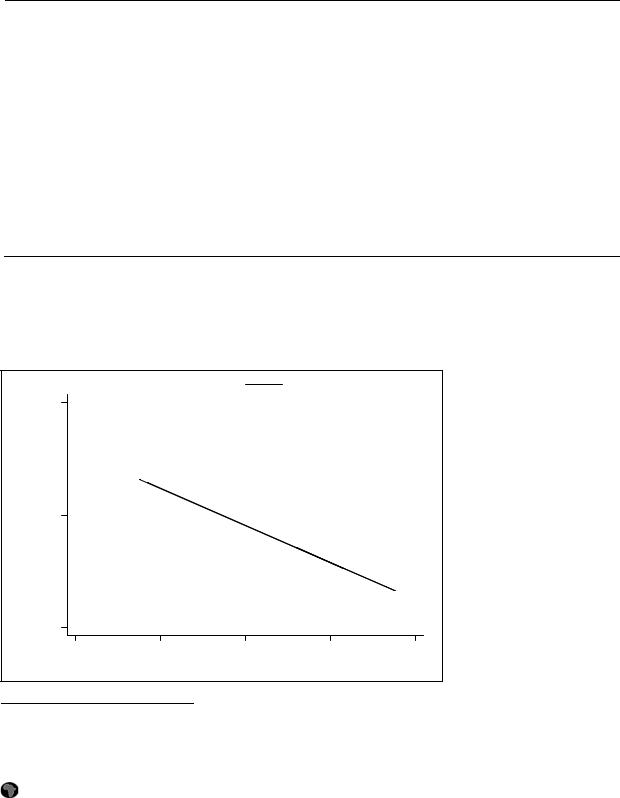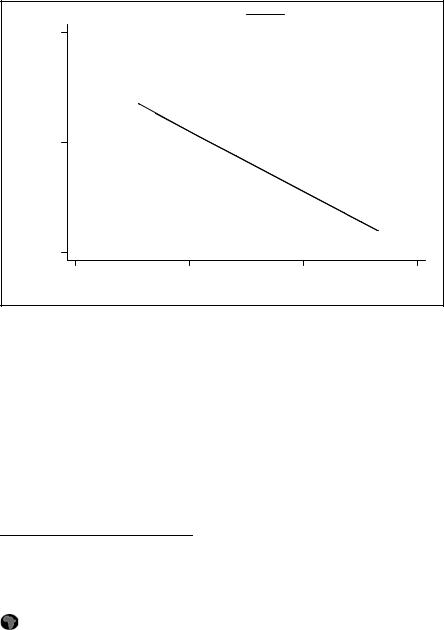
- •AFROBAROMETER WORKING PAPERS
- •Working Paper No. 44
- •SOURCES OF ETHNIC
- •Introduction
- •Sources of Ethnic Identification: Evidence from the Afrobarometer
- •Data and Measurement
- •Ethnic
- •Ethnic Multidimensionality: Evidence from Kenya
- •Data and Measurement
- •Structural Sources of Tribal and Sub-tribal Identifications
- •Political Sources of Tribal and Sub-Tribal Identification
- •Conclusion
- •Broad Ethnic Measure

Sources of Ethnic Identification: Evidence from the Afrobarometer
Data and Measurement
To investigate the sources of ethnic identification in Africa, we employ data collected in Round 1 of the Afrobarometer, a multi-country survey project that employs standardized questionnaires to probe citizens’ attitudes in new democracies in Africa. Round 1 surveys were administered in 12 sub-Saharan African countries between mid-1999 and mid-2001. Nationally representative samples were drawn through a multi-stage, stratified, clustered sampling procedure, with sample sizes sufficient to yield a margin of sampling error of +/- 3 percent at the 95 percent confidence level.1
Round 1 Afrobarometer surveys included a question designed to gauge the salience for respondents of different group identifications. The question was worded as follows:
We have spoken to many [people in this country, country X] and they have all described themselves in different ways. Some people describe themselves in terms of their language, religion, race, and others describe themselves in economic terms, such as working class, middle class, or a farmer. Besides being [a citizen of X], which specific group do you feel you belong to first and foremost?
The main dependent variable used in the analyses in the first part of this paper – the measure of “ethnic salience” – is constructed from the responses to this question by 14,414 respondents in nine countries: Botswana, Malawi, Namibia, Nigeria, South Africa, Tanzania, Uganda, Zambia, and Zimbabwe.2 We coded respondents’ answers to the “which group do you feel you belong to first and foremost” question into five categories: ethnic, race, religion, class/occupation, and other. We defined ethnic responses in two ways. Our principal definition, which we employ in the analyses reported in the main paper, equates ethnicity with tribe (or sub-tribe) and language. However, recognizing that other non-tribal and nonlinguistic identities – e.g., race in South Africa, region in Malawi, religion in Nigeria – are sometimes also understood in ethnic terms, we also coded our dependent variable in a second, more encompassing, way to include these other categories as ethnic responses as well.3 We replicate our main findings using this broader definition in the Appendix.
Before turning to the main findings, three limitations of the analysis bear mention. First, although broadly representative of Africa as a whole, the nine countries included in our study are not a substitute for a continent-wide sample. The nine countries include no Francophone nations, no countries that have failed to introduce at least some democratic or market reforms over the last decade, and, with the exception of Uganda, no countries currently involved in civil wars. As Table 1 indicates, per capita incomes in the nine countries are significantly higher than the African average (though this is driven by the cases of Botswana, Namibia, and South Africa – the other six countries are actually poorer than the average African country). Rates of under-5 mortality in our sample are slightly lower than in Africa as a whole, and urbanization is slightly higher. Ethnic fractionalization – a measure of the likelihood that two
1Further details of the Afrobarometer project, including the sampling procedures used in collecting the data, are available at the project’s web site: www.afrobarometer.org.
2The question was not asked in Ghana. In Mali, the question was included but the codebook did not provide information about response categories until after this version of the paper was completed. The Mali data will be added to future analyses. Lesotho was excluded because the name of the country nationality is identical to the name of the country’s dominant ethnic group, the Sotho (who comprise 99.7 percent of the population, CIA 2003). Thus the survey question (which asks, “besides being Mosotho, which group do you feel you belong to first and foremost?”) rules out an ethnic response by definition.
3In addition to language and (sub-) tribe, the broad ethnic variable codes race as an ethnic response in all nine countries; region as an ethnic response in Malawi, Namibia, Nigeria, South Africa, Tanzania, and Uganda; and religion as an ethnic response in Nigeria.
2
Copyright Afrobarometer

people chosen at random from the country will be from different ethno-linguistic groups – is roughly comparable to what is found on the rest of the continent. But the nine countries in our sample enjoy more extensive political rights than the average African country (on the Freedom House scale, lower numbers indicate greater rights). Our findings therefore must be interpreted with the caveat that they may not be entirely representative of Africa as a whole.
Table 1: How Representative is Our Sample of African Countries?
|
Per capita |
Under-5 |
Percent |
Ethnic |
Political |
|
GNI in US$ |
Mortality per |
Urban |
Fractionalization |
Rights Score |
|
(2000) |
1,000 (2000) |
(2001) |
(Fearon) |
(2000-01) |
All Sub-Saharan Africa |
480 |
162 |
33 |
0.71 |
4.5 |
Nine Sample Countries |
1,130 |
139 |
36 |
0.73 |
3.7 |
Botswana |
3,300 |
99 |
50 |
0.35 |
2 |
Malawi |
170 |
193 |
15 |
0.83 |
3 |
Namibia |
2,050 |
112 |
32 |
0.72 |
2 |
Nigeria |
260 |
153 |
46 |
0.80 |
4 |
South Africa |
3,020 |
79 |
58 |
0.88 |
1 |
Tanzania |
280 |
149 |
34 |
0.95 |
4 |
Uganda |
310 |
161 |
15 |
0.93 |
6 |
Zambia |
300 |
186 |
40 |
0.73 |
5 |
Zimbabwe |
480 |
116 |
37 |
0.37 |
6 |
Notes: GNI, under-5 mortality, and percent urban figures are from World Bank (2002). Ethnic Fractionalization figures are from Fearon (2003). Political rights scores are from Freedom House (2001).
Second, the question from which we construct our dependent variable explicitly bars respondents from describing themselves in terms of nationality: it asks “besides being Namibian, Zambian, Tanzanian, etc, which specific group do you feel you belong to first and foremost.” We therefore cannot rule out the possibility that respondents might consider national identity as more salient than the identity categories that they mention, and that are recorded in our data.
Third, the question provides information about the salience of ethnicity in relative, not absolute, terms. All we are able to infer from respondents’ answers is the identity that they rank first among those identity categories explicitly mentioned in the survey question. We have no way of knowing how much importance respondents attach to their first- (or secondor third-) ranked group memberships. Thus to conclude on the basis of our data that ethnicity is more salient in country A than country B because a larger share of survey respondents in country A ranked ethnicity first is not quite right. It is possible that ethnicity might be more salient in absolute terms to people in country B, even though a larger share of them rank some other category of identity as even more important than ethnicity.
These caveats notwithstanding, the measure of ethnic salience adopted in this paper is superior to that employed in earlier studies, almost none of which measure the salience of ethnicity directly. Most rely on inferences based on the presumed effects of ethnic salience. In effect, they reason that, because there is ethnic violence in the country in question or because voting patterns or the distribution of patronage seem to follow ethnic lines, ethnicity must be a salient motivating factor in people’s behavior. Others rely on assumptions about what the diversity of ethnic groups in a country implies about the salience of ethnicity in the country’s politics – a relationship that we demonstrate in a moment works exactly opposite from the often hypothesized direction. Neither approach is as defensible as the one pursued here, which bases its assessment of ethnic salience on the self-reported identities of individuals as collected in a nationally representative sample survey.
3
Copyright Afrobarometer

The use of self-reported identities does, however introduce the risk of response bias. Respondents in societies where ethnic labels mark people for discrimination or where expressing one’s identity in ethnic terms is frowned upon could potentially be less likely to self-identify in ethnic terms. While these concerns cannot be ruled out, they are dampened by the structure of the Afrobarometer survey, which is conducted confidentially and in private by enumerators who are not affiliated with the government. Also, the Afrobarometer survey is not primarily about ethnicity – the question about how respondents identify themselves was just one of more than 175 questions asked in the questionnaire – so respondents are likely to have treated the ethnic identification question as a background question rather than as the central issue about which the survey was designed to elicit information. Given these factors, we expect that respondents were likely to have been less guarded in their responses about their ethnic identities than might otherwise have been the case.
The Salience of Ethnic Identities
Table 2 reports the frequency distribution of responses to the “which specific group do you feel you belong to first and foremost” question for all respondents taken together, and then broken down for each of the nine countries in the sample. Contrary to the stereotype that Africans are intrinsically “ethnic” people above all else, fewer than a third of the respondents in the nine countries identify themselves first and foremost in ethnic terms. Indeed, ethnic responses are not even the most frequent response type: class/occupation is the most common answer with 40 percent of responses. In addition, responses vary tremendously across countries: whereas 92 percent of respondents in Botswana identify themselves “first and foremost” in ethnic terms, only 3 percent of respondents do so in Tanzania.4 This diversity of responses suggests that the national context matters for the salience of ethnicity – a point to which we shall return shortly. Confidence in the validity of these findings is bolstered by the consistency of the patterns with what we know about the history and politics of the countries in the sample. Race is most salient in countries with large white settler populations and recent histories of racial discrimination (South Africa, Zimbabwe, and Namibia). Class is most salient in the traditionally socialist countries of Tanzania and Zambia (and, less predictably, also in Uganda).
Table 2: Respondent Self-Identifications
“…which specific group do you feel you belong to first and foremost?” (from Afrobarometer)
|
Ethnic |
|
|
Class/ |
|
|
|
Race |
Religion |
Occupation |
Other |
Obs. |
|
All |
0.31 |
0.07 |
0.14 |
0.40 |
0.08 |
14414 |
Respondents |
|
|
|
|
|
|
Botswana |
0.92 |
0.03 |
0.02 |
0.03 |
0.01 |
1196 |
Malawi |
0.59 |
0.02 |
0.11 |
0.23 |
0.05 |
1132 |
Namibia |
0.38 |
0.15 |
0.12 |
0.33 |
0.01 |
838 |
Nigeria |
0.47 |
0.00 |
0.21 |
0.29 |
0.03 |
3516 |
South Africa |
0.17 |
0.34 |
0.19 |
0.16 |
0.15 |
2152 |
Tanzania |
0.03 |
0.00 |
0.05 |
0.79 |
0.12 |
2151 |
Uganda |
0.12 |
0.00 |
0.09 |
0.66 |
0.12 |
1945 |
Zambia |
0.07 |
0.04 |
0.32 |
0.54 |
0.02 |
905 |
Zimbabwe |
0.37 |
0.15 |
0.08 |
0.33 |
0.07 |
930 |
Notes: The “other” category includes gender, region, and other responses. The rows may not sum to 100 percent because of rounding errors.
4 In Botswana, where approximately 80 percent of the country’s population is Setswana, ethnic responses were in terms of sub-tribes (i.e., Mongwato, Mokweme, Mokgatla, and so forth).
4
Copyright Afrobarometer

Moreover, these findings are robust to alternative interpretations of what constitutes an “ethnic” response. Using our broader coding of ethnicity, the share of ethnic responses rises to 45 percent, largely because of increases in the number of responses coded as “ethnic” in Nigeria, South Africa, Namibia, and Zimbabwe (see Appendix, Table A1). But even this figure falls short of what popular perceptions about the centrality of ethnicity in Africa might have led us to expect. Even with this broad measure, only two countries have ethnic responses over 60 percent (Botswana and Nigeria). Cross-country variation in the salience of ethnic identification also remains high.
If Africans are not uniformly “ethnic” people, what makes some Africans more likely to identify in ethnic terms? Although popularly viewed as vestiges of pre-modern society that will wither away in the face of political and economic development, ethnic identities have long been recognized to be products of modernization (Deutsch 1961; Anderson, von der Mehden and Young 1967; Lloyd 1967; Melson and Wolpe 1970; Gulliver 1971; Bates 1983).5 Rather than causing ethnic identifications to “disappear into museums” (Davidson 1992: 100), 40 years of scholarship has shown that urbanization, industrialization, education, political mobilization, and competition for jobs deepen ethnic identities rather than weaken them, as individuals exploit their ethnic group memberships as tools for political, economic, and social advancement. The implication is that we should find the greatest frequency of ethnic responses among urban, educated respondents who are competing for scarce jobs and maximally exposed to political mobilization.
We test these expectations using the Afrobarometer dataset in two stages. First, we address the individual-level determinants of ethnic identification. Then we turn to the country-level factors that predispose individuals to identify themselves in ethnic terms. Descriptive statistics for the data used in these analyses are reported in Table 3.
Individual-Level Sources of Ethnic Identification
The key individual-level determinants of ethnic identification that we investigate are gender, age, education level, occupation, urban/rural location, and media exposure (as proxied by how often the respondent gets his or her news from the radio or from newspapers – Table 4, column 1).6 Given the high degree of variation in the dependent variable across countries, we employ country fixed effects in column 1, and extensive country controls later. We also cluster regression disturbance terms at the country level in all specifications in Table 4.
Gender has no effect, and the effect of age is weak. The point estimate on the age variable implies that an increase in twenty years (roughly half the average life expectancy in the countries in the sample) would increase the likelihood that a respondent identifies him or herself in ethnic terms by just over 3 percent.
Education, however, has a strong effect, even when controlling for other variables like occupation. Compared to people with at least some primary education (the omitted category), respondents with no formal education are nearly 11 percent less likely to say that they feel they belong to an ethnic group first and foremost. Even a small amount of formal education appears to increase the likelihood that a
5During the 1950s and 1960s “it was accepted that…parochial ethnic loyalties were mere cultural ghosts lingering on into the present, weakened anomalies from a fast receding past…[that] were destined to disappear in the face of the social, economic and political changes that were everywhere at work” (Vail 1989: 1). Notwithstanding Vail’s claim that “people from all sectors of the political spectrum believed in this vision,” it is almost impossible to find examples of serious scholars who actually predicted that ethnic identities would evaporate in the face of modernization.
6Questions about respondents’ household incomes are only included in five of the round 1 Afrobarometer surveys (Ghana, Mali, Nigeria, Tanzania, and Uganda), so the effect of wealth can only be explored at the country level, which we do in the next section. Note that, in contrast to other Afrobarometer publications, we do not weight our individual-level analyses by country size.
5
Copyright Afrobarometer

respondent will identify him or herself in ethnic terms. Beyond primary schooling, however, additional education has little impact on the likelihood an individual self-identifies in ethnic terms.
Table 3: Descriptive Statistics (for Afrobarometer Analysis)
Variable |
Mean |
Std. dev. |
Obs. |
Panel A: Individual-level characteristics |
|
|
|
Female |
0.50 |
0.50 |
14414 |
Age (years) |
35.0 |
13.5 |
14414 |
No formal education |
0.13 |
0.34 |
14414 |
Some primary education |
0.15 |
0.36 |
14414 |
Completed primary education |
0.19 |
0.39 |
14414 |
Some secondary education |
0.22 |
0.41 |
14414 |
Completed secondary education |
0.18 |
0.39 |
14414 |
At least some post-secondary education |
0.12 |
0.32 |
14414 |
Occupation: Farming or fishing |
0.24 |
0.43 |
14414 |
Occupation: White collar, teacher, or government employee |
0.16 |
0.36 |
14414 |
Occupation: Blue collar or miner |
0.13 |
0.34 |
14414 |
Occupation: Student |
0.08 |
0.28 |
14414 |
Occupation: Business, shop keeper, or petty trader |
0.16 |
0.37 |
14414 |
Occupation: Other (e.g., unemployed, housewife, don’t know) |
0.22 |
0.41 |
14414 |
Lives in rural area |
0.57 |
0.50 |
14414 |
Gets news from radio daily |
0.57 |
0.49 |
14414 |
Gets news from newspaper at least weekly |
0.31 |
0.46 |
14414 |
Panel B: Country-level characteristics |
|
|
|
Log per capita income (2000, 2000 US$ – source: World Bank 2003) |
6.2 |
1.0 |
14414 |
Ethnic fractionalization – Fearon (source: Fearon 2003) |
0.79 |
0.18 |
14414 |
Ethnic fractionalization – Alesina (source: Alesina et al. 2003) |
0.74 |
0.15 |
14414 |
Ethno-linguistic fractionalization (source: Easterly and Levine 1997) |
0.81 |
0.14 |
14414 |
Size of largest ethnic group (source: Morrison et al. 1989) |
0.35 |
0.20 |
14414 |
Politically relevant ethnic groups score (source: Posner 2004b) |
0.55 |
0.16 |
14414 |
Proximity to closest next or previous election, in months (source: authors) |
8.3 |
5.5 |
14414 |
Average political rights, 1-7 (last 10 years, 1 is best – source: Freedom |
4.4 |
1.5 |
14414 |
House) |
|
|
|
Notes: The education categories are mutually exclusive. The occupation categories are mutually exclusive. Reported figures are unweighted by country size.
The salience of ethnicity also varies strongly with occupation. Compared to farmers and fishermen (the omitted category), blue collar workers/miners, students, business people, and the unemployed are significantly more likely to identity themselves in ethnic terms. The effect is strongest for students, who are more than 12 percent more likely to identify themselves in ethnic terms than farmers or fishermen.7 One interpretation of this pattern is that strong ethnic identification among students stems from the competition that they know they will face with their fellow graduates for scarce jobs, and the role that ethnic ties may play in securing employment.
We also find that respondents living in rural areas tend to be less likely than urban residents to privilege their ethnic group memberships, although this result is only statistically significant at traditional confidence levels in one of the specifications.8
7The finding for students is robust to the exclusion of the education indicator variables.
8The urban variable remains insignificant if we drop the occupation indicator variables, so the finding is not an artifact of colinearity between occupation and urbanization. This is probably because of heterogeneity of individual types in the rural domain.
6
Copyright Afrobarometer

Table 4: Sources of Ethnic Identity: Individual and Country Characteristics
|
Dependent variable: Ethnic identity |
||
|
“describes respondent best” |
||
|
(1) |
(2) |
(3) |
Female |
-0.010 |
0.001 |
0.002 |
|
(0.018) |
(0.015) |
(0.012) |
Age (years) |
0.0016* |
0.0008 |
0.006 |
|
(0.0008) |
(0.0009) |
(0.006) |
No formal education |
-0.106*** |
-0.038 |
-0.017 |
|
(0.035) |
(0.044) |
(0.030) |
Completed primary education |
-0.002 |
-0.068 |
-0.053 |
|
(0.014) |
(0.042) |
(0.038) |
Some secondary education |
0.005 |
-0.014 |
-0.024 |
|
(0.028) |
(0.026) |
(0.017) |
Completed secondary education |
0.012 |
0.039 |
0.024 |
|
(0.035) |
(0.043) |
(0.042) |
At least some post-secondary education |
-0.026 |
0.009 |
-0.042 |
|
(0.043) |
(0.049) |
(0.059) |
Occupation: White collar, teacher, or government employee |
0.015 |
0.066*** |
0.054 |
|
(0.024) |
(0.022) |
(0.037) |
Occupation: Blue collar or miner |
0.103*** |
0.203*** |
0.184*** |
|
(0.018) |
(0.025) |
(0.040) |
Occupation: Student |
0.123*** |
0.246*** |
0.245*** |
|
(0.022) |
(0.032) |
(0.042) |
Occupation: Business, shop keeper, or petty trader |
0.062*** |
0.136*** |
0.120*** |
|
(0.014) |
(0.025) |
(0.039) |
Occupation: Other (e.g., unemployed, housewife, don’t know) |
0.117*** |
0.164*** |
0.147*** |
|
(0.020) |
(0.022) |
(0.039) |
Lives in rural area |
-0.035 |
-0.118*** |
-0.079 |
|
(0.039) |
(0.047) |
(0.055) |
Gets news from radio daily |
-0.011 |
-0.041** |
-0.049*** |
|
(0.011) |
(0.017) |
(0.018) |
Gets news from newspaper at least weekly |
-0.047** |
-0.097*** |
-0.085*** |
|
(0.019) |
(0.020) |
(0.033) |
Log per capita income (in 2000, 2000 US$) |
|
-0.119** |
-0.158*** |
|
|
(0.057) |
(0.051) |
Ethnic fractionalization – Fearon measure |
|
-0.74*** |
-0.77*** |
|
|
(0.28) |
(0.24) |
Proximity to closest next or previous election, in months |
|
-0.023*** |
-0.024*** |
|
|
(0.008) |
(0.007) |
Average political rights, 1-7 (1 is best) – Freedom House |
|
-0.078 |
-0.120** |
|
|
(0.052) |
(0.055) |
Country fixed effects |
Yes |
No |
No |
Country population weights |
No |
No |
Yes |
Observations (respondents) |
14414 |
14414 |
14414 |
Notes: Probit estimation, with marginal coefficient estimates (at mean values for the explanatory variables). Huber robust standard errors in parentheses. Significantly different than zero at 90 percent (*), 95 percent (**), 99 percent (***) confidence. Regression disturbance terms are clustered at the country level. The omitted education category is “Some primary education”. The omitted occupation category is “Occupation: farming or fishing”. The F-test on the hypothesis that all of the country fixed effects (in regression 1) equal zero has p-value<0.001. Regression 3 weights each observation by 1 / (Number of Afrobarometer observations for the country in which the respondent is located), thus effectively weighting each country equally.
7
Copyright Afrobarometer

Taken together, the findings are broadly consistent with the hypothesis that “modern” individuals – individuals who are educated, working in non-traditional occupations, and living in urban areas – are more likely to identify in ethnic terms. One important caveat comes when we look at media exposure. Exposure to news through newspapers and radio seems to dampen ethnic salience, whereas the modernization scholarship cited earlier would lead us to expect the opposite relationship. It may be that media exposure is too coarse a measure of “modernization.” An alternative hypothesis is that the relationship between modernity and ethnic salience is curvilinear: both those least exposed to modern currents and pressures and those most exposed to them (for example, those who never read the newspaper and who do so every day) are least likely to view their as fate bound up with their ethnic affiliation, and thus are less prone to identify themselves in ethnic terms. The pattern of coefficient estimates on the employment indicators is broadly consistent with this view, as white-collar employees, teachers, and government workers are somewhat less likely than lower status blue collar employees, shopkeepers, traders, and students to identify in ethnic terms.
Country-level Sources of Ethnic Identification
Having considered individual-level sources of ethnic identification, we turn to the country-level. The country-level variables we introduce both complement and complicate the modernization story we have explored thus far. First, and most provocatively, we find a challenge to the assumption that higher degrees of ethnic fractionalization lead to greater ethnic salience. Second, we find strong support for the modernization thesis about the relationship between political mobilization and the salience of ethnicity: both the proximity of national elections and the degree of political rights enjoyed by a country’s citizens affect the likelihood that respondents will identify themselves in ethnic terms. The key limitation of these results is the inclusion of only nine countries in the analysis, but data limitations make this impossible to overcome (until further rounds of Afrobarometer data are made publicly available).
We present two different country-level specifications. In columns 2 and 3 of Table 4, we replace the country fixed effects with measures of the country’s per capita income, degree of ethnic fractionalization, the number of months since the previous (or before the next) election, and a measure of the country’s average level of political rights over the past ten years. Column 2 presents the model in unweighted form, while column 3 weights each observation by 1/(number of observations from that country). The main effect of including the country population weights is to reduce the influence of Nigeria, which accounts for 25 percent of the total respondents in our analysis. Since we are concerned here with country-level effects, the regression that includes the country weights is the preferred specification.
We first investigate the impact of per capita income on the salience of ethnicity. While we find the log of per capita income to be negatively related to ethnic salience, the substantive effect is small: the coefficient estimate suggests that a country’s per capita income would have to increase ten-fold in order to generate a 16 percent drop in the share of the population identifying itself in ethnic terms.
A more substantively and theoretically important finding is that ethnic fractionalization is negatively related to the salience of ethnicity in the countries in question.9 In the large literature that employs indices of ethnic fractionalization to account for outcomes such as civil war (Collier 2001; Elbadawi and Sambanis 2002; Reyna-Querol 2002), economic growth (Easterly and Levine 1997; Collier and Gunning 1999; Alesina, et al. 2003), and the quality of governance (Mauro 1995; La Porta, et al. 1999), ethnic diversity is frequently used as a proxy for the salience of ethnic identity per se. Our results suggest that the assumption underlying this approach has it exactly backwards. It turns out that the more diverse a country is, the less salient ethnicity is for its citizens (Table 4, columns 2 and 3). For a sense of the magnitude of this relationship, an increase in ethno-linguistic fractionalization of 0.18, or one standard deviation in our sample, is associated with a reduction in expressed ethnic identification of 14 percentage
9 We use Fearon’s (2003) measure, which we feel to be the most reliable.
8
Copyright Afrobarometer

points, a very large effect (column 3). This finding is extremely robust: it holds under multiple measures of ethnic diversity (see Table 5), when using the broader measure of ethnicity (see Appendix, Table A2), and is not driven by any single country.10 Figures 1 and 2 make clear graphically that no single country drives the result.
Table 5: Sources of Ethnic Identity: Ethnic Diversity Measures
|
|
|
Dependent variable: |
|
|
|
|
|
Ethnic identity “describes respondent best” |
|
|||
|
(1) |
(2) |
(3) |
(4) |
(5) |
(6) |
Ethnic fractionalization – Fearon measure |
-0.83** |
-0.77*** |
|
|
|
|
Ethnic fractionalization – Alesina measure |
(0.44) |
(0.24) |
-0.67** |
|
|
|
|
|
|
|
|
||
Ethno-linguistic fractionalization |
|
|
(0.28) |
-1.02*** |
|
|
|
|
|
|
|
||
Size of largest ethnic group |
|
|
|
(0.39) |
0.80*** |
|
|
|
|
|
|
||
Politically relevant ethnic groups score |
|
|
|
|
(0.19) |
-1.10*** |
|
|
|
|
|
||
|
|
|
|
|
|
(0.15) |
Individual and country characteristics, |
No |
Yes |
Yes |
Yes |
Yes |
Yes |
and country population weights |
|
|
|
|
|
|
Observations (respondents) |
14414 |
14414 |
14414 |
14414 |
14414 |
14414 |
Notes: Probit estimation, with marginal coefficient estimates (at mean values for the explanatory variables). Huber robust standard errors in parentheses. Significantly different than zero at 90 percent (*), 95 percent (**), 99 percent (***) confidence. Regression disturbance terms are clustered at the country level. The individual and country characteristics and weights are as in Table 4, regression 3.
Figure 1: Ethnic Identity “Describes Respondent Best” and Ethnic Fractionalization, Fearon Measure (with fitted regression line)
|
Ethnic identity |
|
Predicted values |
|
1 |
|
|
|
|
|
BOTSWANA |
|
|
|
|
|
|
MALAWI |
|
.5 |
|
|
NIGERIA |
|
|
ZIMBABWE |
|
NAMIBIA |
|
|
|
|
|
|
|
|
|
S AFRICA |
|
|
|
|
UGANDA |
|
|
|
|
ZAMBIA |
|
0 |
|
|
TANZANIA |
|
|
|
|
|
|
.2 |
.4 |
.6 |
.8 |
1 |
|
|
Ethnic fractionalization, Fearon |
|
|
10 When countries are dropped one at a time, the coefficient estimate on ethnic fractionalization remains large, negative and significant in all cases (regression not shown). This holds even for Botswana and Zambia, the two apparent outliers in Figure 1.
9
Copyright Afrobarometer

This empirical finding is consistent with theoretical claims advanced by Collier (2001) and Bates (2000) regarding the relationship between ethnic diversity and politics. They argue that ethnic rivalries are likely to be muted in highly diverse societies, since no single ethnic group is strong enough to attain power on its own under such conditions and incentives will arise for cooperation across ethnic lines. At very low levels of diversity, ethnicity will also not be salient for the simple reason that everyone is a member of the same group. But as ethnic diversity increases from very lower levels to the middle of the range, ethnicity will become more and more salient, as minority groups begin to challenge the dominant ethnic group for power. Ethnicity becomes most salient in a situation where two more or less equally sized groups are competing for power. Our empirical results, while consistent with this curvilinear hypothesis, do not allow us to test it completely, since we do not have country observations in the relevant range: even the most ethnically homogeneous societies in our nine-country sample (Botswana and Zimbabwe) are reasonably ethnically diverse, with fractionalization measures in the 0.4 range (see Figures 1 and 2). So our sample only allows us to capture the right (downward sloping) part of the curve.
Figure 2: Ethnic Identity “Describes Respondent Best” and Ethnic Fractionalization, ELF Measure (with fitted regression line)
Ethnic identity |
|
Predicted values |
|
1 |
|
|
|
BOTSWANA |
|
|
|
|
MALAWI |
|
|
.5 |
|
NIGERIA |
|
ZIMBABWE |
|
NAMIBIA |
|
|
|
|
|
|
|
S AFRICA |
|
|
|
UGANDA |
|
|
|
ZAMBIA |
|
0 |
|
TANZANIA |
|
|
|
|
|
.4 |
.6 |
.8 |
1 |
|
Ethno-linguistic fractionaliz. |
|
|
A second central finding of our analysis is that the salience of ethnicity is closely related to the intensity of political competition in the country in question. We find that the proximity of the timing of the Afrobarometer survey to a national election is a highly significant explanatory variable: the closer the survey is to an election (i.e., the greater the proximity), the more likely respondents are to respond that they view themselves first and foremost in ethnic terms (Table 4, columns 2 and 3). The interpretation of the electoral proximity coefficient is that, all else equal, a respondent in a country that is holding an election at the time of the survey will be almost 30 percentage points more likely to identify him or herself in ethnic terms than a respondent in a country whose election took place a year ago, or whose election is scheduled to take place a year hence.11 This finding has clear implications not just for the sources of ethnic identification but also for the design and implementation of survey research, since surveys conducted near election time appear to generate systematically different response patterns. As
11 There is no statistically significant difference between the effect of time since an election and time before an election on the extent of ethnic identification (regression not shown), so we focus on a measure that treats time before versus after an election symmetrically.
10
Copyright Afrobarometer
